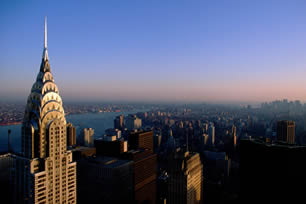Guggenheim Museum
A masterpiece of modern architecture exhibiting one ot the world's finest collections of modern and contemporary art.
One of New York ’s most famous and highly visited attractions for tourists and local residents alike, the Solomon R. Guggenheim Museum is one of the world’s most easily recognizable structures. Possibly more renowned for its unique spiral shell than its internationally celebrated collections of art, it remains one of the most significant architectural icons of the 20th century.
The Guggenheim is also the heart of an international network of museums - the others are located in Venice, Bilbao, Berlin and Abu Dhabi. Visitors can experience a range of modern and contemporary art exhibitions, including performance art, lectures by artists, film screenings, classes and daily tours.
In 1943, Frank Lloyd Wright was commissioned to design a building to house the Museum of Non-Objective Painting, which had been established by the Solomon R. Guggenheim Foundation four years earlier. It took Wright over 15 years to complete due to his utter dedication to creating the perfect piece of architectural art. It is believed he discarded over 700 sketches and six sets of near-completed drawings before he sent his final designs to the architects.
The finished structure caused much controversy when it was unveiled in 1959, its unusual design sticking out somewhat amongst the more classic neighbouring buildings. Reactions ranged from revulsion to critical acclaim, but today Wright's architectural talents are as much a draw to the Guggenheim as the art itself. Sadly, he died before the museum was completed.
The Guggenheim Museum was founded on a raft of early modern masterpieces and its collection now spans the late 1800s through most of the 20th century, including significant works by Cézanne (such as Plate of Peaches and Bibémus), Degas (Dancers in Green and Yellow), Monet (Palazzo Ducale Seen from San Giorgio Maggiore), Van Gogh (Landscape with Snow and Mountains at Saint-Rémy), and Picasso (including the Woman with the Yellow Hair).
The interior is a spiral allowing continuous movement through the exhibits and providing an immersive, integrated experience: art within art. As the gallery increases upward at a relatively steep incline, it is best to start at the top and work downwards - indeed most of the special, temporary exhibits are planned to be seen this way. These short-term gems are particularly celebrated, and ever-changing, so be sure to check the schedule before visiting.
As is the case at the Museum of Modern Art, backpacks and other large items, including double-sided strollers and large bags, are not allowed in the museum. However, the collection can be easily viewed within an afternoon, making it a palatable experience and easy to fit into a hectic trip.
The Guggenheim is certainly a must for both art and architecture fans.




